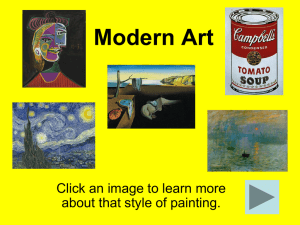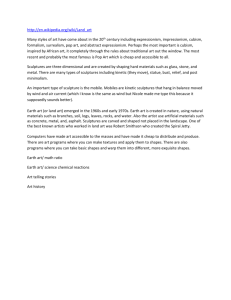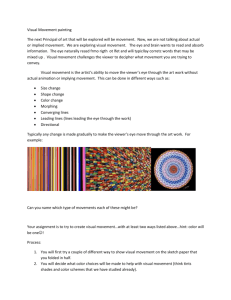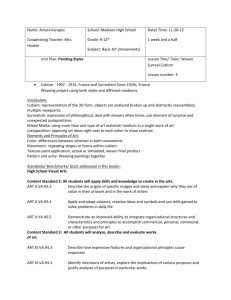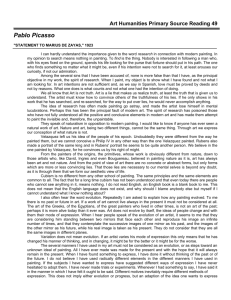- .-
advertisement
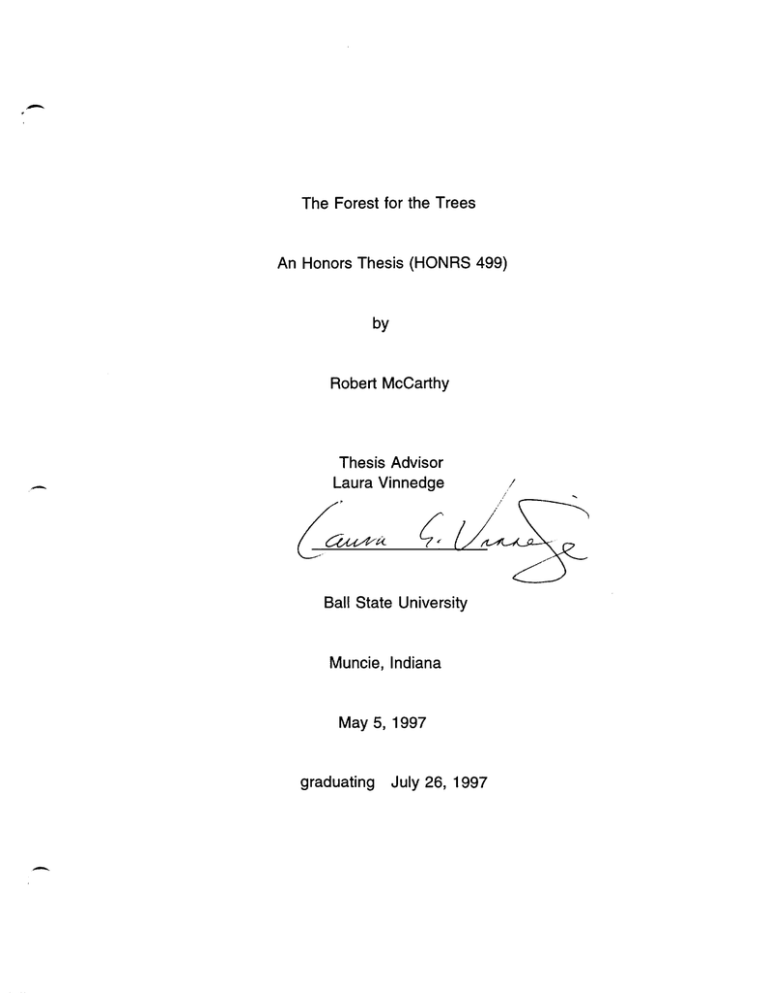
The Forest for the Trees An Honors Thesis (HONRS 499) by Robert McCarthy .- Thesis Advisor Laura Vinnedge Ball State University Muncie, Indiana May 5,1997 graduating - July 26, 1997 / C)pCO I,' 1~~C0f5 Bob McCarthy The Forest for the Trees ,- In my current drawings and paintings, I am trying to combine two movements, Pop art and Cubism, to create a new and different style where any icon, or pictorial representation, becomes appropriate and may be presented in a fashion that focuses on the processes of gestalt and time. Cubism, as an art form, deals with the perception of the viewer. It takes a subject, such as a portrait, still life, or landscape, and forces the viewer to see the fourth dimension of time by including different points of view. It shows movement through repetition of shape, line, and color, relying on the viewers' process of gestalt to form a complete image. Pop art, as seen by the likes of Jasper Johns, Andrew Warhol, and Roy Lichtenstein, deals with banal and common-place objects of contemporary society and uses them to confront the viewer. Brooms, numbers, soup cans, and comic books are transformed from factory-made kitsch to objects of art. The two styles are related in that the artists involved both challenged what art is. Where Cubism challenged how a picture should be painted, Pop art questioned what is appropriate for subject matter. On the flip side of that, Cubism generally relied on established subject matter (portraits, still life, . . .) and Pop art did not have a set style for production or presentation of its images. In combining two separate styles, it is necessary to examine and explain the effects of each. The fact that both styles force the viewer to re-define what art, beauty, and painting means is what I find interesting. In this way, they are metacognitive (thinking about the process of thinking), meaning that they are paintings that are focused on what painting is. With Cubism, Braque, Picasso, and other related artists pose the question of how a picture "should look." Rather than employing Renaissance-like realism, with illusionary perspective, they reflect on what painting's function could be. Why, in this age of cameras, videos, and computers, must we record just one moment in time with .- - our paintings? Cameras should not make painting obsolete, but should rather free the artist to choose to be more subjective in his or her dealings with time, movement, and representation. This idea makes it necessary to radically change the "look" of my paintings. As Picasso put it, "Cubism, if not more realistic, is a more complete image for our modern, fast-paced world." Pop art is metacognitive, not in regards to technique or how the image should look, but what the image should be. Prior to pop art, There were subjects that were considered appropriate for fine art. These included female nudes, portraits, landscapes, religious or mythological scenes, and still lives. These images eventually became established icons, or pictorial representations, in the art world. When Pop art was established, it confronted these icons by presenting mundane, ordinary objects as fine art and making them icons of this age. By making an object as ordinary as a telephone into an art object, Pop art, in a sense, was iconoclastic, destroying the very idea of icons in art. Since EVERYTHING can now be employed as an icon, then what's special about them? Nothing. The metacognitive aspect is brought into the subject matter depicted. I think that Cubism, in terms of technique, was headed toward something like Pop art as it progressed from analytic to synthetic cubism. If not cut short by the war, I think that Cubism would have developed much more and be an even more important influence in painting today. The Art Nouveau style and Symbolism dealt with technique and subject matter much along the same lines that cubism and pop art did. Both Art Nouveau and Cubism focus on technique, while Symbolism and Pop art focus on imagery and subject matter. this is not to say that there is no theory involved with the cubistic technique (nor that technique isn't involved with pop art- it is!) It is just my opinion that, just with every style, one has overpowered the other. To me, Cubism and Pop art should work off of each other just as Symbolism and Art Nouveau did to create Abstract Expressionism. When art nouveau began, they had theories of symbolizing abstract forms to "stir a man's soul," but eventually, just as with Cubism, the technique or process became more important than the theory. Symbolism dealt with questioning what a "proper" picture - was. Female nudes weren't just beauty to gaze at, but confronted the viewer in "femme fatale" fashion. In this way, both Symbolism and Pop art dealt with subject matter. "What is art?" for Pop art and "What is beauty?" for Symbolism. If Art Nouveau and Symbolism could combine to create a whole new art form, then Cubism and Pop art has the potential to do so as well. I see Pop art works such as Rauschenburg's combines and paintings as modern extensions of cubism- from works like Picasso's three musicians, with paper and collage. But it goes beyond the technique or mere physical aspects of the two styles. Warhol's and Rosenquist's works create movement within their pieces through repetition of symbols and pictures or juxtaposition of separate images. Repetition of icons creates a stop-motion effect that comments on time- creating motion without motion. Combining separate images forces the viewer to find a similarity between the images or some sort of thread or idea that ties the images together. Consider Rauschenberg's Retroactive I or Buffalo II and Rosenquist's President Elect. Notice the way that other images, such as astronauts, eagles, cake, and automobiles, are used for different effects. Rauschenberg's kennedy is placed, for the most part, among patriotic symbols of our country, where Rosenquist has named him as another product to be consumed by the American public. Of course there are similarities in intent as well, but I don't want to break these paintings down completely, I only want to point out how two works can use the same basic starting image to portray completely different sides of it. This is a "modern cubism." As far as repetition of symbols, one thinks of Warhol's 100 Cans as an immediate example. I would rather concentrate on the Pop artists' series of works, such as Warhol's Cola series, Rauschenberg's Curfew or Coca-Cola plan, Wesselmann's Great American Nudes (pick a number. .. ), and so on. Take any Pop artist and he probably did a piece that involved a cola (How could they not?). What happens, though, when these pieces are looked at collectively is that rather than one artist's perception of a Coke bottle (or Pepsi, let's be fair) shines through as THE symbol or icon, the viewer is forced to take the IDEA of a coke bottle as an icon in itself. The fragmentation takes place through many different paintings rather than just one. The important part though is that the Viewer is the one combining these images and creating his or her own for the icon of "cola." It is also important to note here that none of the artists are making direct social statements about their subject matter. The fragmentation they create is ambivalent as well as tied in with our modern world. "The Pop artists selected a format that, like TV, blurs distinction between actual events and staged recreations, direct statements and innuendo, fact and fiction, and denotation and connotation" (Pop art and Consumer Culture, p 79). - With the concept of time and the gestalt phenomenon being my major interests in painting, it follows that my most repeated motif is the idea of cycles. Everything seems to, at the same time, be at a certain phase in its own cycle while acting as a point for larger cycles. It's difficult to explain without being redundant, but is based on the ideas of time and gestalt. Everything is continually changing (inner cycle) and that these changes tend to group together into larger cycles (outer cycle). With this in mind, I am always coming up with new images, or icons, and considering how they (the icons) are affected by cycles or changes. Obviously, the circle motif lends itself to this. The circle becomes a symbol for cycles and I often use it in conjunction with other geometric shapes. The other shapes take the role of being a point in the larger cycle. The female figure is used a number of times and tends to come off as a "beginner" of cycles to me. Standing figures are images I've experimented with, and they are always interesting results. One figure in a work compared to two or more creates completely different moods for the painting. Other than basic ideas like these, the image chosen is random. I never start off drawing something in order to express a certain message, nor does it have to fit into a grand design of any kind. I simply draw an image that is interesting to me, for whatever reason, and then attempt to see it in terms of time, gestalt, and change. I choose to use paints as my medium because of its subjective quality. Where cameras or film seem to record time and motion as matter-of-factly as possible, painting IS better able to make some sort of comment about it. I think that the reason for this is that part of the film medium is time, itself. It is directly connected where painting is not, which allows the painter to be free in his dealing with it. - Painting for me, as it is for many artists, is a way to escape for a while. It is a time to think or meditate. The act of painting becomes separate from the final result. I say "separate" rather than more important, because the final result is the goal you are working towards and the act of painting is the process used to achieve that goal. Neither is more important. When I start a painting, I have a specific image in mind that is drawn on to the canvas. How that image is changed as I work is more random. Normally, once an image is drawn, I begin breaking it down into simple geometric shapes, such as triangles, circles, squares, or lines. While considering the balance and composition of shapes within the entire work, I'll start repeating and overlapping certain shapes in an attempt to draw attention to focal points and abstract other areas. Once I am satisfied with the composition, I will repeat the process with color. Starting with basic colors, random shapes are painted in. As it progresses, I try to note how colors affect the importance of certain shapes, compared to how important the shape is to the image and composition of the work. This eventually leads to a new layer of shapes based on color composition. This process creates tensions in the work in two major ways. The first is the joining of the original image with the compositional, geometric shapes. Where my images usually begin rather non-active or at rest, the geometric abstractions attempt to add a sense of movement and rythm. Many times, I see two different types of movement within an image. The first is action, such as Nude Descendin& a Staircase. by Duchamp, where the figure is physically moving and the painting is capturing that movement. The second is a much more subtle movement that is not actually physical. By arrangmg the shapes in a certain way, an object can appear "at rest" and still be dynamic. The second tension created by my pamtmg process is how the geometric rythms and composition are affected by the addition of color. Many times, color being added requires more shapes in order to draw attention to certain areas and dull other areas back down. this creates two layers of shapes that in some areas work together and, in others, clash violently. Often, this is the stage where the painting becomes really interesting to me. - the main focus in cubism (why it looks like it does) is TIME. Not only does the viewer get the impression of different physical views, but movement as well. Icons instinctively, by definition, are timeless. While the exact image may vary as time progresses, the same icons will affect the viewers. If I choose to use icons in my work, I must consider what ones are particularly powerful (what form?). Or ... are my personal "power" icons (ones that affect me) strong enough to affect others? Consider, for example, an iconic image. Admit that the exact image must change with time. For example, the nude- the renaissance "nude" icon is different than today's in at least two major ways. The first difference is the type of nude that we find beauty in, physically. In the time of the old masters and Greek art, women were beautiful if they had some meat on those bones. Now, women are expected to be Much thinner. A second difference is how the nude should be portrayed in order to receive a specific response. another way to put this is, what we find beauty in, mentally. Should the nude be a passive muse or an active participant? Both of these are simply changing societal values. This goes for any image- Pop art showed us that. A U.S. map is now an art icon. So are soup cans! In fact, anything can become an Icon. The question of whether something is or isn't an icon is now moot- thank you Duchamp! An important part of the Pop movement, though, was finding the "correct" mundane object to show as an icon. For instance, Jasper ,- - John's searching for the "right" telephone. The realistic portrayal of an icon eventually dates a work. That particular image of a phone IS different than how this new generation views a phone... now it's cellular, touch tone, whatever. The point is that this is where cubism's technique comes into the picture. One need not find 100 different phones and try to guess the "future phone" in order to keep the icon image from becoming an image of nostalgia, because Cubism naturally fragments and distorts the image. It attempts to portray the impression or feel of "phone" and gives it an abstract sense of timelessness(thank you cubism), while the icon remains established (thank you Pop art). Rather than forming ABSTRACT expressionism, as Symbolism and Art Nouveau did, Cubism and Pop art may create a REPRESENTATIONAL expressionism. The viewer is involved with reconstructing the image and considering its validity. Going back to the "nude" icon, one must remember that when you see a nude, you are actually seeing an icon for beauty. This doesn't work for photography or realism because the actual image of what is beautiful will always be changing. With "representational expressionism," though, the viewer creates the actual image in his or her head, using gestalt, by sharing the icons in the work with the artist. Through recognition of the icons, a sense of timelessness can be created. As you can see, creating a sense of timelessness is difficult to explain. Every artwork carries a sense of time. I think that the more realistic an image is, the more it becomes dated, or set in a time period, which is not good or bad. The viewer is still given a sense of time in how he relates back to the artwork's time period. By fragmenting the image (abstracting), the viewer must focus on the image or the artwork- its elements or principles... but mainly the image. That is the only relation that the viewer has to it. If you could suggest an image and force the viewer to help create it, he has a new role. The time sense is transferred from realism (viewer's age and artwork's age) to an inner, mostly unconscious, comment about time. ~- Gestalt is the process of combining separate elements to create a greater whole. Three taps becomes a rythm; two dots, a circle, and a semi-circle combine to become a smiley face The sum is greater than its parts. A+B+C<D Seeing the forest for the trees. ,-- - The process of gestalt is used by everyone, everyday. No exceptions, although most people aren't aware of it. As I, paint, I try to remain very aware of HOW all these small shapes and images are combining to create an over-all image. Once the image is on the canvas, the viewer uses gestalt to recreate it. One of the main focuses of mine is to observe how the gestalt process works and the limits to it. What is the effect of a color here? A shape there? What is implied when the viewer does or doesn't see "it," or sees something else? Does one make the painting bad? Good? no. What does matter? The fact that they are using your work to make what connections they are making, no matter WHAT they are. A painting is successful to a person if the viewer pauses to take it in, THINKS about it, and wants to go back to it. What's successful, as far as the artist is concerned, is subjective and changes. For him or her, it's more of a respect for the work than anything else. The peculiar way that cubism deals with gestalt allows the viewer to re-create the picture in hislher mind. Same icon, different image per Viewer. When used previously, with accepted, representational subject matter, this gestalt created movement or time within the picture. This is changed when dealing with Pop art theory. The viewer won't see a nude descending a staircase that looks as though she may be moving. Rather, slhe sees a series of images that slhe is forced to find beauty in (Pop art). From there, they reflect on that series of images and recreate one image, and a sense of time, within themselves. The difference between what painting means to me and what others see in my work merely shows the practice and experience I need to really show the viewer how s/he is participating. Until that point, I must rely on how I am participating and my role in the process. As I improve, years later, I will be able to completely synthesize theory and production. I have a long way to go to be able to communicate these basic ideas to the vIewer through my paintings, but it is already happening for me, so it's only a matter of practice and ... TIME. - Bibliography Mahsun, Carol Anne. Pop Art and the Critics. Research press, 1987. Ann Arbor: Mamiya, Christin J. Pop Art and Consumer Culture. University of Texas Press, 1992. Rosenblum, Robert. 1977. Austin, Texas: Cubism and Twentieth Century Art. Roskill, Mark. the Interpretation of Cubism. Alliance Press, 1985. UMI New York, Philadelphia: the Art
